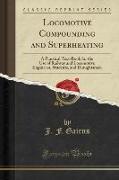- Start
- Locomotive Compounding and Superheating
Locomotive Compounding and Superheating
Angebote / Angebote:
Excerpt from Locomotive Compounding and Superheating: A Practical Text-Book for the Use of Railway and Locomotive Engineers, Students, and Draughtsmen
It is now just upon thirty years since the first practical compound locomotives were built, but even yet the compound locomotive does not occupy the universally accepted position which theory would suggest that it should do. But whereas in the early years of its existence as a definite feature of locomotive engineering practice it was looked upon in most quarters with disfavour and distrust, and the engineers first concerned with the design of such engines had to contend against prejudice and opposition, and had no easy task to obtain even a trial of their systems, now the position is far more favourable, and compound locomotives according to many different systems are to-day in use to the number of many thousands in various parts of the world. In fact, it is not claiming too much to say that the compound locomotive occupies to-day an assured position, and it is probable that before many years have passed it will become a standard feature of locomotive engineering in all countries.
As regards compounding for locomotives, Great Britain has maintained its reputation for conservatism, for its record in this respect is not a very satisfactory one as compared with the experimental and original work to be attributed to foreign locomotive engineers, but this is largely the result of different circumstances and policy.
In this country the Locomotive Superintendent or Chief Mechanical Engineer of a railway is responsible for the design and efficiency of large numbers of locomotives doing very hard and greatly varied work, but he is not encouraged to experiment or to depart radically from standard methods: and in most cases he has to design engines which are developments of previously existing designs, each class being somewhat more powerful, more reliable, and yet more simply and cheaply constructed proportionately than its predecessors. The engines are also generally required to be capable of doing much work for which they are not specially designed. Consequently, actual novelties are few in British locomotive history, and notable experiments and changes in methods of design occur only once or twice during, it may be, a long term of service of a particular engineer as locomotive chief.
About the Publisher
Forgotten Books publishes hundreds of thousands of rare and classic books. Find more at www.forgottenbooks.com
This book is a reproduction of an important historical work. Forgotten Books uses state-of-the-art technology to digitally reconstruct the work, preserving the original format whilst repairing imperfections present in the aged copy. In rare cases, an imperfection in the original, such as a blemish or missing page, may be replicated in our edition. We do, however, repair the vast majority of imperfections successfully, any imperfections that remain are intentionally left to preserve the state of such historical works.
Folgt in ca. 5 Arbeitstagen




